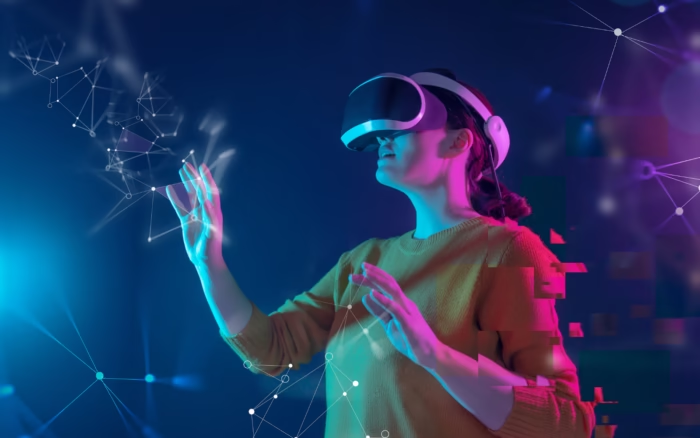Contents
- Introduction
- What is the Metaverse?
- Origins of the Metaverse
- Key Components of the Metaverse
- Real-Life Use Cases of the Metaverse
- Economic Opportunities in the Metaverse
- Metaverse Projects to Watch
- Risks and Challenges
- How to Get Started in the Metaverse
- Final Thoughts
- Ready to Step into the Metaverse?
- Related Blog Posts You Might Like
Introduction
Imagine a world where your job, your favorite concert, your investments — even your identity — exist in a shared, immersive digital universe. That’s not a scene from a sci-fi film; it’s the rapidly evolving reality of the Metaverse.
Once just a speculative concept, the Metaverse is becoming a functional, user-driven space where virtual and physical realities merge. With the rise of blockchain, NFTs, and immersive technology, this new frontier is shaping how we live, work, play, and earn online.
What is the Metaverse?
The Metaverse is a digital, interconnected universe that combines augmented reality (AR), virtual reality (VR), blockchain technology, and the internet to create persistent, shared experiences.
In simple terms, it’s a virtual environment where people can:
- Own land, items, or identities as NFTs
- Interact in real-time with others using avatars
- Build, trade, and monetize digital assets
- Attend concerts, meetings, and exhibitions virtually
Origins of the Metaverse
The term “Metaverse” was first coined in Neal Stephenson’s 1992 novel Snow Crash, where users navigated a virtual world through digital avatars. Fast forward to today — with tech giants like Meta (Facebook), Microsoft, and blockchain pioneers involved — the Metaverse is transitioning from fiction to fact.
Key Components of the Metaverse
1. Virtual Worlds
Platforms like Decentraland, The Sandbox, and Roblox offer rich virtual spaces where users can explore, build, and interact.
2. Digital Identity & Avatars
Avatars represent your virtual self. You can personalize them, buy clothes or gear as NFTs, and use them across different metaverse platforms.
3. NFTs & Digital Ownership
NFTs play a foundational role by proving ownership of:
- Digital land
- Art
- In-game items
- Virtual fashion
4. Interoperability
Future Metaverses aim to connect platforms seamlessly, letting assets and identities move fluidly across games, marketplaces, and social spaces.
Real-Life Use Cases of the Metaverse
🕹️ Gaming
Games like Axie Infinity and Illuvium are turning gameplay into income streams. Players earn tokens, trade NFT assets, and participate in virtual economies.
🎨 Art & Culture
Virtual galleries allow artists to exhibit and sell NFT art globally. Platforms like OnCyber and CryptoVoxels host immersive exhibitions.
🏢 Virtual Real Estate
Users can purchase parcels of digital land to develop stores, casinos, art galleries, or event spaces. A plot in Decentraland’s Fashion District sold for $2.4 million.
🎶 Entertainment
Musicians like Travis Scott and Ariana Grande have hosted concerts in virtual spaces like Fortnite and Wave, reaching millions of fans simultaneously.
💼 Remote Work & Collaboration
Platforms like Spatial and Horizon Workrooms are pioneering the virtual office, enabling teams to work together in immersive 3D environments.
Economic Opportunities in the Metaverse
| Sector | Description |
|---|---|
| Play-to-Earn | Gamers earn real income via NFT-based game assets |
| Virtual Real Estate | Buy and sell land, charge rent, host events |
| Fashion | Sell digital wearables and accessories as NFTs |
| Freelance & Services | Provide design, marketing, or development in virtual worlds |
Metaverse Projects to Watch
| Project | Focus Area | Highlights |
|---|---|---|
| Decentraland | Virtual World | Land ownership, VR-enabled, DAO-governed |
| The Sandbox | Gaming & Creativity | Voxel-style worlds, LAND NFTs, SAND token |
| Meta (Horizon Worlds) | Social Spaces | Built by Facebook, VR-first experience |
| Somnium Space | Immersive VR | High-res, VR-first metaverse on Ethereum |
| NFT Worlds | Minecraft-based | Play-to-earn worlds built on Web3 |
Risks and Challenges
- Hardware Barriers: High-quality VR gear is still costly.
- Centralization Risks: Corporate platforms may limit user control.
- Privacy Concerns: Massive data collection in immersive environments.
- Regulatory Uncertainty: Legal clarity for virtual property, identity, and earnings is evolving.
How to Get Started in the Metaverse
- Create a Digital Wallet: Use MetaMask or WalletConnect to store crypto and NFTs.
- Choose a Metaverse Platform: Try Decentraland, Sandbox, or Roblox depending on your goals.
- Explore & Customize: Build an avatar, buy wearables, attend events.
- Invest Carefully: If buying land or assets, research thoroughly and avoid hype-driven purchases.
- Participate: Attend live concerts, exhibit art, play games, or create virtual experiences.
Final Thoughts
The Metaverse isn’t just a digital trend — it’s the evolution of the internet into a fully immersive, interactive, and owned environment. While the technology is still maturing, the foundations are in place, and pioneers are already building the future.
Whether you’re a gamer, artist, entrepreneur, or just curious, now is the time to explore this bold new dimension.
Ready to Step into the Metaverse?
Create your first avatar on Decentraland, explore digital lands on The Sandbox, or shop for wearables at OpenSea. Your virtual journey starts now.
